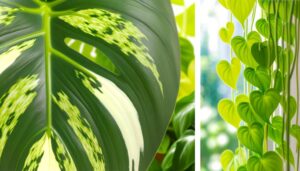How to Care for a Split Leaf Philodendron Monstera Deliciosa Live Plant
To care for a Split Leaf Philodendron Monstera Deliciosa, select a terracotta pot with drainage holes, 2-4 inches larger than the root ball. Use a well-draining soil mix of peat moss, pine bark, and perlite.
Water thoroughly when the top inch of soil is dry, ensuring proper drainage. Position the plant in bright, indirect light and maintain temperatures between 65°F and 85°F with humidity levels at 60-80%.
Prune dead or damaged leaves using sterilized tools and apply a water-soluble fertilizer monthly. Regularly inspect for pests and use neem oil if needed.
For a more detailed guide, continue exploring.
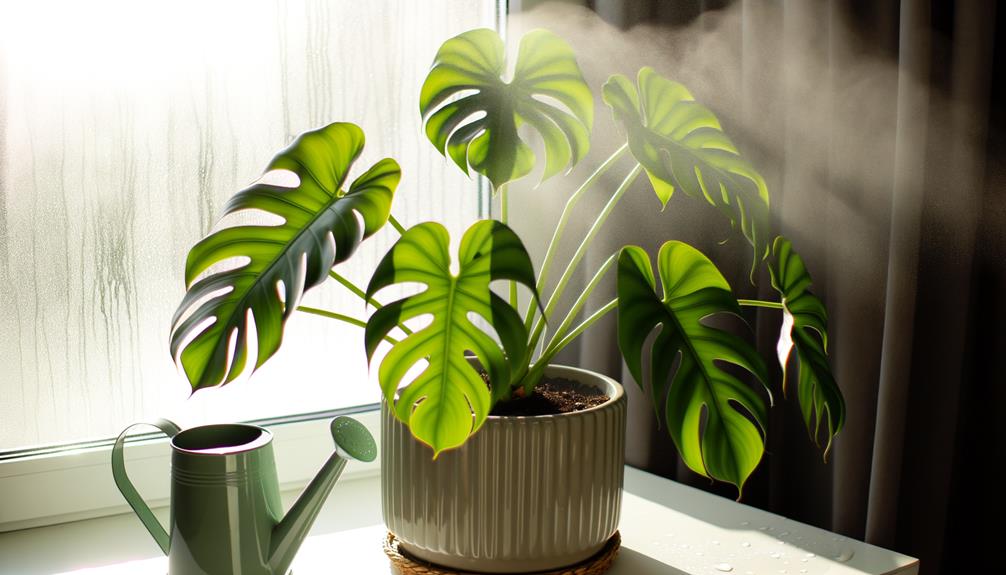
Key Takeaways
- Provide bright, indirect light and avoid direct sunlight to prevent leaf damage.
- Keep soil consistently moist, allowing the top inch to dry before watering again.
- Use a well-draining potting mix of peat moss, pine bark, and perlite.
- Maintain humidity levels at 60-80% and ensure good air circulation.
- Prune yellow or wilted leaves with sterilized tools and apply a gentle fungicide.
Choosing the Right Pot
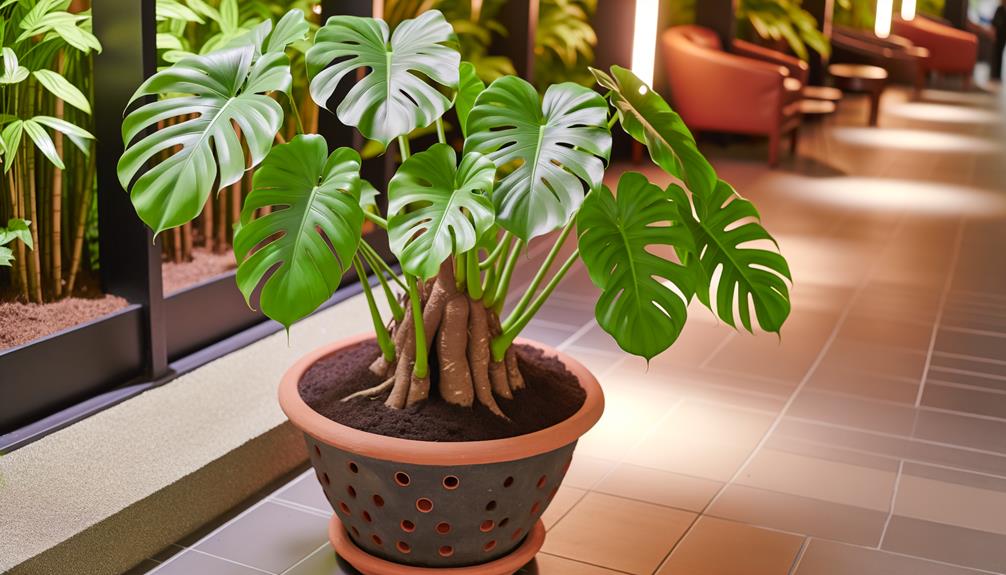
Choosing the right pot is crucial for the healthy development and structural stability of a Split Leaf Philodendron Monstera Deliciosa. The pot should have sufficient drainage to prevent water accumulation, which can result in root decay. A container with drainage holes is vital.
Select a pot that is 2-4 inches larger in diameter than the plant's root ball to allow for root expansion. Materials such as terracotta are recommended due to their breathable nature, improving air circulation. Make sure the pot is strong enough to support the plant's significant weight and height.
For best growth, consider repotting every 1-2 years to replenish soil nutrients and accommodate root growth. Proper pot selection reduces root confinement and enhances overall plant health.
Ideal Soil Mix
For best growth, Monstera Deliciosa requires a well-draining potting mix composed of equal parts peat moss, pine bark, and perlite.
This specific blend guarantees sufficient drainage and aeration, thereby preventing root rot and promoting healthy root development.
Additionally, incorporating a small amount of activated charcoal can further improve soil aeration and prevent fungal growth.
Potting Soil Composition
An perfect soil blend for a Split Leaf Philodendron Monstera Deliciosa should be well-draining, nutrient-rich, and comprised of a combination of peat moss, perlite, and orchid bark.
Peat moss retains moisture while providing essential organic nutrients. Perlite enhances aeration and prevents soil compaction, vital for root health. Orchid bark contributes to overall soil structure and further improves drainage.
To create this best mixture, combine 40% peat moss, 40% perlite, and 20% orchid bark. This ratio guarantees a balanced medium that supports robust growth and minimizes risks of overwatering.
Additionally, incorporating a slow-release fertilizer can provide sustained nutrient availability. Regularly check soil pH, aiming for a slightly acidic range between 5.5 and 7, to optimize nutrient uptake.
Drainage and Aeration
In addition to a well-balanced soil composition, ensuring sufficient drainage and aeration is vital for the health of a Split Leaf Philodendron Monstera Deliciosa. Ideal soil mix should consist of a blend of one-third peat moss, one-third perlite, and one-third pine bark. This mixture promotes excellent water drainage while retaining essential moisture.
Aeration is essential to prevent root rot and encourage healthy root development. Experts suggest using a pot with drainage holes to allow excess water to escape. Additionally, incorporating horticultural charcoal can improve air circulation within the soil matrix.
Regularly checking the soil's texture and adjusting the components as needed will optimize the Monstera Deliciosa's thriving in its environment.
Proper Watering Techniques
Achieving ideal hydration for a Split Leaf Philodendron Monstera Deliciosa involves maintaining consistently moist soil without allowing it to become waterlogged, which can lead to root rot. Utilize a well-draining potting mix and guarantee the container has adequate drainage holes.
Water the plant thoroughly until water exits the drainage holes, then allow the top inch of soil to dry out before the next watering. Employing a moisture meter can provide accurate soil moisture readings, preventing overwatering.
During the growing season in spring and summer, increase watering frequency, while reducing it in fall and winter when growth slows. Employ room temperature, filtered water to avoid shocking the roots with cold or chlorinated water.
Light Requirements
The Split Leaf Philodendron Monstera Deliciosa thrives in bright, indirect light, replicating its natural understory habitat. It is imperative to avoid direct sunlight, as it can cause leaf scorch and damage the plant's delicate foliage.
Best light conditions include placing the plant near a north or east-facing window, ensuring diffused lighting for robust growth.
Ideal Light Conditions
Providing perfect light conditions for a Split Leaf Philodendron Monstera Deliciosa involves ensuring bright, indirect sunlight to mimic its natural tropical habitat.
Position the plant near an east or west-facing window where it can receive filtered light for several hours daily. Utilize sheer curtains to diffuse direct sunlight, preventing potential leaf scorch.
Employing artificial grow lights can supplement natural light, particularly in dim indoor environments or during winter months. A light meter can be an invaluable tool to measure light intensity, aiming for 1000-2500 foot-candles.
Regularly rotate the plant to promote even growth and avoid phototropism. Monitoring the plant's response to light adjustments will ensure optimal health and growth, enhancing its characteristic fenestrations and lush foliage.
Avoid Direct Sunlight
While bright, indirect sunlight is beneficial, it is crucial to avoid exposing the Split Leaf Philodendron Monstera Deliciosa to direct sunlight to prevent leaf burn and damage. Excessive direct light can cause chlorophyll degradation, resulting in pale, scorched leaves. Position the plant in an area where it can receive filtered light or dappled shade, such as near a north or east-facing window.
Consider the following expert tips to ensure ideal light conditions:
- Sheer Curtains: Use sheer curtains to diffuse intense sunlight.
- Artificial Lighting: Implement grow lights if natural light is insufficient.
- Seasonal Adjustment: Relocate the plant during different seasons to match its light needs.
Following these guidelines will promote healthy growth and vibrant foliage.
Temperature and Humidity
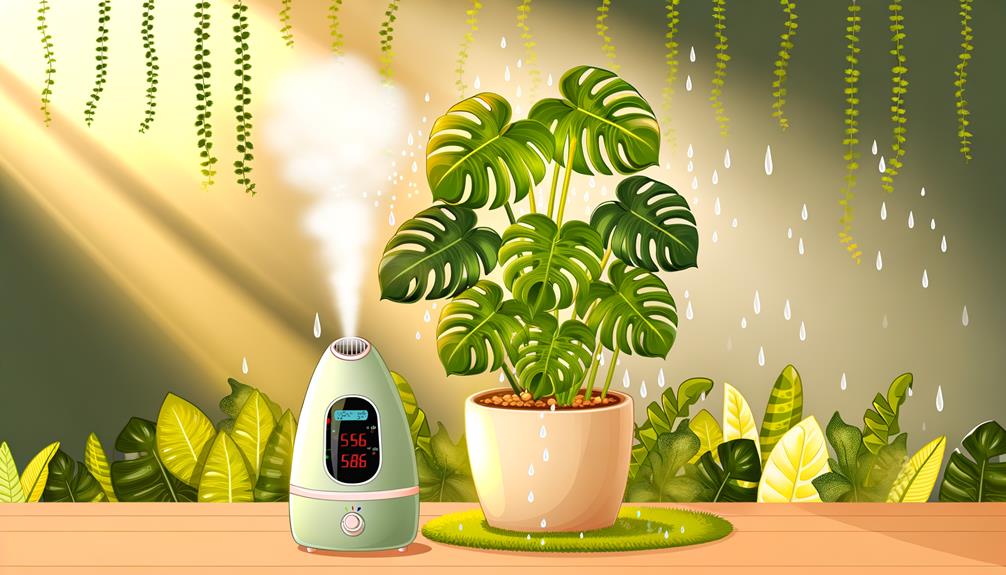
Maintaining ideal temperature and humidity levels is crucial for the health and growth of a Split Leaf Philodendron Monstera Deliciosa. Best temperatures range between 65°F to 85°F (18°C to 29°C). Avoid exposing the plant to temperatures below 55°F (13°C) as it may cause growth retardation or leaf damage.
Humidity levels should be sustained at 60-80%, mimicking the plant's natural tropical environment. Utilize a hygrometer to monitor humidity and employ a humidifier if necessary. Alternatively, place the plant on a humidity tray or regularly mist the foliage. Promote air circulation to prevent fungal growth.
Adhering to these parameters will foster robust growth and vibrant foliage, enhancing the overall health of your Monstera Deliciosa.
Fertilizing Tips
To achieve peak growth and vibrant foliage for your Split Leaf Philodendron Monstera Deliciosa, apply a balanced, water-soluble fertilizer with an N-P-K ratio of 20-20-20 during the growing season.
Fertilize the plant biweekly from early spring through late summer, making sure you dilute the fertilizer to half strength to prevent nutrient burn. Monitor the plant's response and adjust frequency as necessary.
Key points include:
- Application Timing: Fertilize biweekly during the active growing period.
- Dilution: Dilute the fertilizer to half strength to avoid over-fertilization.
- Observation: Regularly inspect foliage for signs of nutrient deficiencies or excesses.
Implementing these fertilizing tips will secure robust growth and enhance the overall health of your Monstera Deliciosa.
Pruning and Maintenance
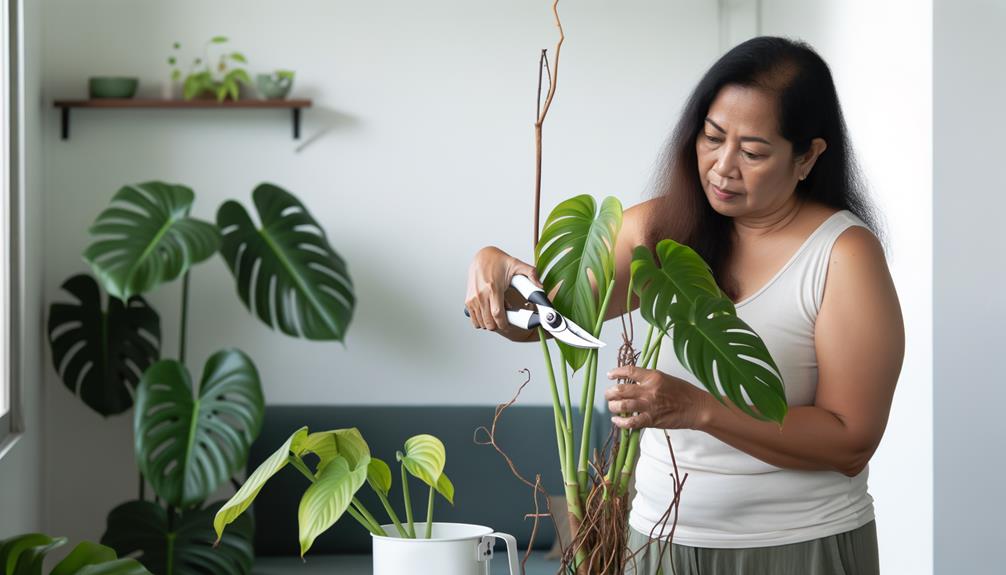
Pruning and maintenance of Monstera deliciosa are vital for ideal growth and aesthetics. Regularly trim dead or yellowing leaves using sterilized pruning shears to prevent disease and promote healthy foliage.
Additionally, strategic pruning of leggy stems will encourage new growth and maintain the plant's desired shape.
Trimming Dead Leaves
Eliminating dead foliage from a Split Leaf Philodendron Monstera Deliciosa is a crucial aspect of its overall health and well-being. This process not only enhances the plant's visual appeal but also prevents potential pest infestations and diseases.
To effectively trim dead leaves, follow these expert recommendations:
- Sterilize Your Tools: Use a sharp, sanitized pair of pruning shears to prevent the spread of pathogens.
- Identify and Eliminate: Carefully pinpoint leaves that are yellow, brown, or wilted and trim them close to the base, avoiding harm to healthy tissue.
- Post-Pruning Care: Properly discard the trimmed leaves and consider applying a gentle fungicide to the cut areas to prevent infections.
Following these steps guarantees a flourishing and lively Monstera Deliciosa.
Encouraging New Growth
Promoting new growth in a Split Leaf Philodendron Monstera Deliciosa involves strategic pruning and meticulous maintenance to stimulate robust development and ensure best plant health.
Prune using sterilized, sharp shears to remove any leggy, damaged, or yellowing stems. Cut just above a leaf node to encourage branching and denser foliage.
Maintain a regular pruning schedule, ideally during the growing season (spring and summer), to optimize light penetration and air circulation.
Additionally, clean leaves with a damp cloth to enhance photosynthesis and prevent pest infestations.
Applying a balanced, water-soluble fertilizer monthly can provide essential nutrients, further promoting vigorous growth.
Regularly inspect the plant for pests and diseases, addressing issues promptly to maintain overall essentiality.
Supporting Growth
Supporting the growth of a Split Leaf Philodendron Monstera Deliciosa involves providing ideal conditions for light, humidity, and nutrients. This tropical plant thrives in environments that replicate its natural habitat. To ensure best growth, it is essential to focus on the following factors:
- Light: Position the Monstera in indirect, bright light to mimic the dappled sunlight of forest canopies. Avoid direct sunlight, which can cause leaf burn.
- Humidity: Maintain a humidity level of 60-70%. Utilize a humidifier or place the plant on a pebble tray filled with water to increase ambient moisture.
- Nutrients: Fertilize with a balanced, water-soluble fertilizer every 4-6 weeks during the growing season. Make sure the soil mix is rich in organic matter for sustained nutrient release.
Repotting Guidelines

Repotting a Split Leaf Philodendron Monstera Deliciosa should be done every 1-2 years to promote root health and sustained growth. Select a pot that is 2 inches larger in diameter than the current container to allow adequate space for root expansion.
Utilize a well-draining potting mix, preferably composed of equal parts peat, perlite, and pine bark. Gently remove the plant from its existing pot, taking care to disentangle and prune any damaged roots.
Place the Monstera at the same soil depth as previously planted, ensuring the root ball is centered. Water thoroughly post-repotting to settle the soil and eliminate air pockets.
Position the plant in indirect sunlight to facilitate acclimatization and mitigate transplant shock.
Pest Control
Implementing an integrated pest management plan is crucial for maintaining the health of your Split Leaf Philodendron Monstera Deliciosa. Focusing on early detection and biological control methods can effectively mitigate common pests such as spider mites, scale insects, and mealybugs.
Regular inspections of the plant's foliage and stems can facilitate early identification of infestations. Employing biological controls, such as introducing beneficial insects like ladybugs, can naturally reduce pest populations. Additionally, maintaining appropriate humidity levels and guaranteeing proper air circulation can deter pests.
- Use neem oil or insecticidal soap for treatment.
- Introduce predatory insects to the environment.
- Regularly clean leaves with a damp cloth to remove pests.
These strategies will help ensure a thriving and pest-free Monstera Deliciosa.
Common Issues and Solutions

Addressing common issues such as yellowing leaves, root rot, and leaf drop is vital for maintaining the health and aesthetic appeal of your Split Leaf Philodendron Monstera Deliciosa.
Yellowing leaves often indicate chlorosis, caused by inadequate light or nutrient deficiencies; make sure the plant receives indirect sunlight and periodically apply a balanced fertilizer.
Root rot, primarily due to overwatering, can be mitigated by using well-draining soil and allowing the top inch of soil to dry out between watering.
Leaf drop may result from sudden changes in temperature or humidity; maintain consistent environmental conditions and avoid drafts.
Regular inspection and prompt action are necessary to prevent these issues from escalating, ensuring your plant thrives.
Conclusion
To sum up, the meticulous attention given to Monstera deliciosa covers a range of essential aspects for its care, including ideal pot selection, soil composition, hydration methods, light requirements, temperature, and humidity levels. This comprehensive approach also involves structural reinforcement, transplant procedures, and pest control. These elements collectively contribute to promoting robust growth and visual attractiveness of the plant.
This undertaking can be likened to a journey in horticulture, where each step plays a crucial role in ensuring the health and well-being of the Monstera deliciosa. By following these guidelines, plant owners not only guarantee lush foliage but also equip themselves to tackle various plant-related challenges effectively.
Indeed, the quest for flawless plant care is a commendable mission that demands commitment and knowledge. By staying dedicated and informed, individuals can avoid the shame of neglecting their botanical companions and instead enjoy the rewards of a thriving Monstera deliciosa in their indoor space.






